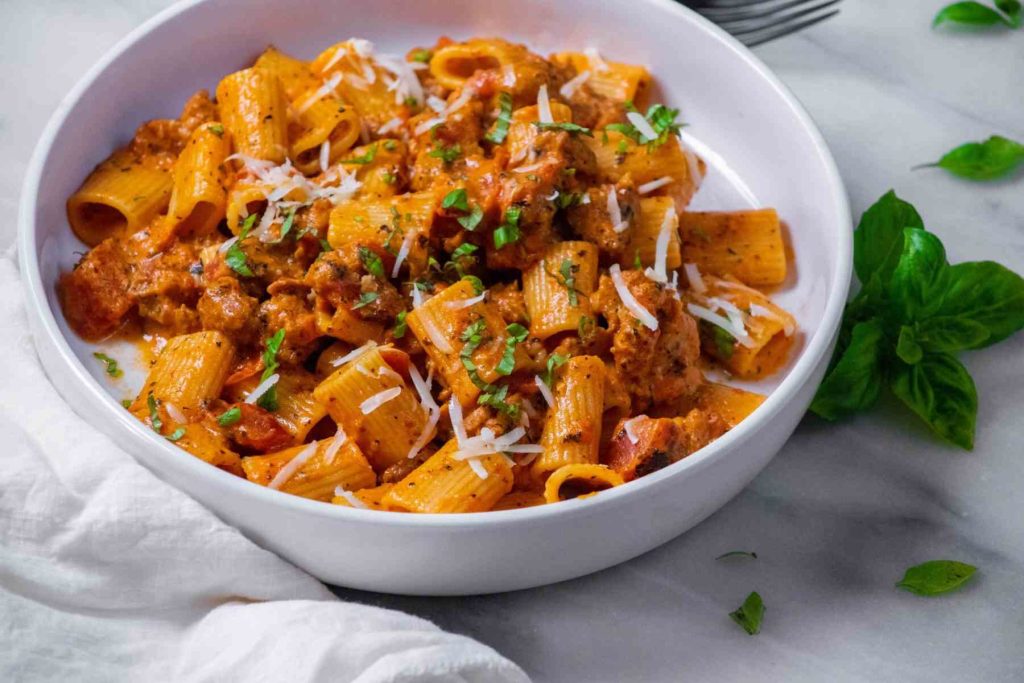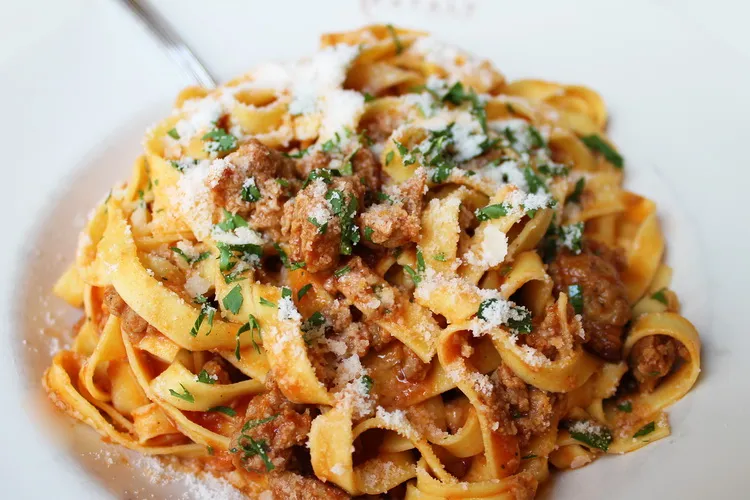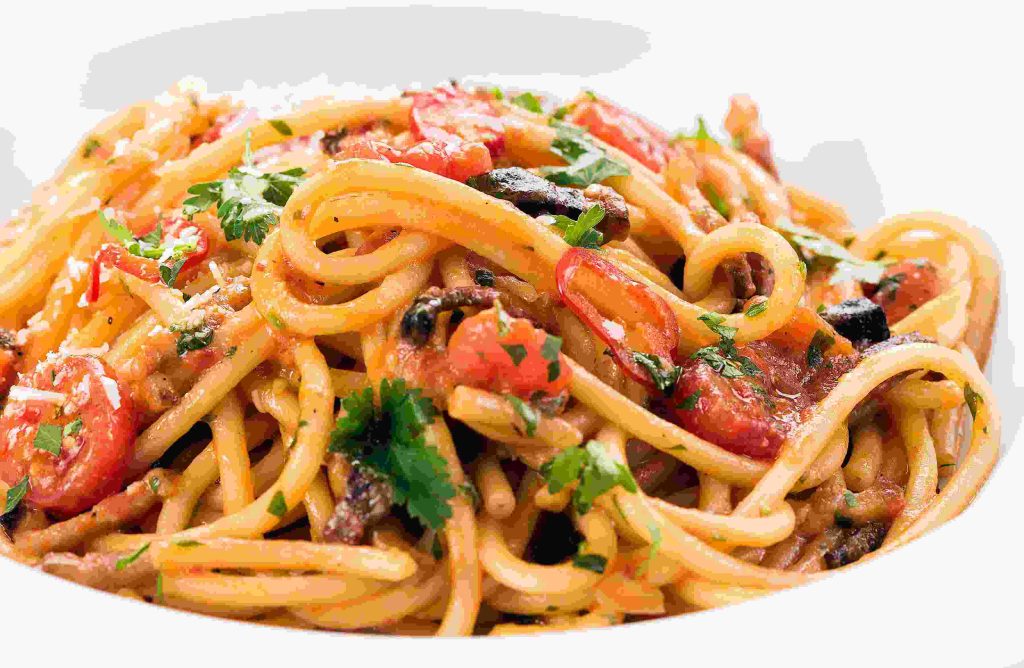Introduction:
Traditional Italian Pasta Recipes Italian cuisine is renowned for its diversity, rich flavors, and deep-rooted traditions. Among the many culinary treasures Italy offers, pasta holds a special place. Each region of Italy has its unique pasta recipes, often passed down through generations, showcasing local ingredients and cooking techniques. This article explores some traditional Italian pasta recipes that highlight the essence of Italian culinary artistry.

1.Spaghetti alla Carbonara
Originating from Rome, Spaghetti alla Carbonara is a classic pasta dish known for its simplicity and robust flavor. The dish traditionally consists of spaghetti, eggs, Pecorino Romano cheese, guanciale (cured pork cheek), and black pepper.
Recipe:
Cook spaghetti in salted water until al dente.
In a separate pan, cook guanciale until crispy.
Beat eggs in a bowl and mix with grated Pecorino Romano and black pepper.
Combine the hot, drained pasta with the guanciale and its rendered fat.
Remove from heat and quickly stir in the egg and cheese mixture to create a creamy sauce. Serve immediately.
2.Pesto alla Genovese
Hailing from Genoa in the Liguria region, Pesto alla Genovese is a vibrant green sauce made from fresh basil, pine nuts, garlic, Parmesan cheese, and olive oil. It is typically served with trofie or trenette pasta.
Recipe:
In a mortar and pestle (or blender), combine fresh basil leaves, garlic, and pine nuts. Grind until a paste forms.
Slowly add grated Parmesan cheese and olive oil, blending until smooth.
Toss the sauce with cooked trofie or trenette pasta. Garnish with extra Parmesan and a drizzle of olive oil.
3.Tagliatelle al Ragù Bolognese
From Bologna, this rich and hearty meat sauce, known simply as “ragù,” is traditionally served with tagliatelle pasta. The sauce is simmered for hours to develop its deep, complex flavors.
Recipe:
Add ground beef and pork, cooking until browned.
Stir in tomato paste, red wine, and crushed tomatoes. Simmer the sauce on low heat for at least two hours, stirring occasionally.
Cook tagliatelle until al dente and toss with the ragù. Serve with grated Parmesan cheese.
4.Orecchiette con Cime di Rapa
A beloved dish from Puglia, Orecchiette con Cime di Rapa (little ears with turnip tops) is a rustic pasta recipe that combines orecchiette pasta with the slightly bitter greens of turnip tops, garlic, and anchovies.
Recipe:
Cook orecchiette pasta in salted water until al dente.
In a pan, sauté garlic and anchovy fillets in olive oil until the anchovies dissolve.
Add cime di rapa (or broccoli rabe) and cook until tender.
Toss the cooked pasta with the greens and garlic mixture. Finish with a sprinkle of red pepper flakes and a drizzle of olive oil.
5.Lasagne alla Bolognese
Lasagne alla Bolognese, a hallmark of Emilia-Romagna cuisine, is a layered pasta dish featuring ragù Bolognese, béchamel sauce, and sheets of fresh pasta.
Recipe:
Prepare ragù Bolognese as described above.
Make béchamel sauce by melting butter, stirring in flour to form a roux, and gradually whisking in milk until thickened. Season with salt and nutmeg.
In a baking dish, layer fresh lasagna sheets with ragù, béchamel, and grated Parmesan.
Repeat the layers and finish with a layer of béchamel and cheese on top.
Bake in a preheated oven at 375°F (190°C) for 30-40 minutes, until bubbly and golden. Let rest before serving.
6.Cacio e Pepe
Another Roman classic, Cacio e Pepe (cheese and pepper), is a minimalist dish that relies on the quality of its few ingredients: Pecorino Romano cheese, black pepper, and pasta (typically spaghetti or tonnarelli).
Recipe:
Cook pasta until al dente, reserving some pasta water.
Toast freshly ground black pepper in a pan.
Add cooked pasta to the pan with a splash of pasta water.
Gradually add grated Pecorino Romano, tossing vigorously to create a creamy sauce. Add more pasta water if needed.
Serve immediately with additional black pepper and cheese.
Conclusion
Traditional Italian pasta recipes are a testament to Italy’s culinary heritage, each dish telling a story of its region and people. From the bustling streets of Rome to the rustic countryside of Puglia, these recipes offer a taste of Italy’s diverse and delicious flavors. Whether you are a seasoned chef or a home cook, these traditional dishes provide an authentic and satisfying culinary experience.
Why does Italian pasta taste better?
Italian pasta is celebrated worldwide for its exceptional taste, a reputation built over centuries of culinary tradition and expertise. There are several reasons why Italian pasta stands out in terms of flavor and quality, from the choice of ingredients to the meticulous preparation methods. Here, we delve into the factors that contribute to the superior taste of Italian pasta.

1.Quality of Ingredients
One of the primary reasons Italian pasta tastes better is the quality of ingredients used. Italy is renowned for its high standards in food production, and pasta is no exception. The key ingredients in pasta—durum wheat semolina and water—are carefully selected for their quality.
Durum Wheat Semolina: Italian pasta is often made from durum wheat semolina, which has a high protein and gluten content. This gives the pasta its firm texture and ability to hold its shape during cooking. The durum wheat used in Italy is of exceptional quality, often harvested from the country’s fertile regions like Puglia and Sicily.
Water: The water used in making pasta, especially in artisanal pasta production, can influence the taste and texture. In Italy, many pasta producers use mineral-rich water from specific regions, adding a unique flavor profile to the pasta.
2.Traditional Techniques
Italian pasta-making techniques have been perfected over generations. Artisanal pasta makers, or “pastai,” follow traditional methods that enhance the pasta’s flavor and texture.
Bronze Die Extrusion: Many Italian pasta producers use bronze dies to shape the pasta. This method roughens the pasta’s surface, allowing it to hold onto sauces better, enhancing the overall flavor of the dish.
Slow Drying Process: Industrial pasta is often dried quickly at high temperatures, which can affect its taste and texture. In contrast, traditional Italian pasta is dried slowly at low temperatures. This method preserves the pasta’s natural flavor and nutritional value.
3.Cultural Heritage and Culinary Expertise
Italian cuisine is deeply rooted in the country’s culture and history. The knowledge and expertise passed down through generations play a crucial role in making Italian pasta taste superior.
Regional Specialties: Each region of Italy has its own pasta varieties and preparation methods, often using local ingredients that add distinct flavors. For instance, the rich and hearty ragù of Bologna, the pesto of Liguria, and the seafood pasta dishes of coastal regions each offer unique tastes.
Passion and Pride: Italians take great pride in their culinary traditions. This passion is evident in the care and attention to detail that goes into every step of pasta-making, from selecting ingredients to cooking and serving.
4.Perfect Pairing with Sauces
Italian pasta dishes are renowned for their perfect balance of pasta and sauce. The right pairing of pasta shapes with sauces enhances the overall taste experience.
Shape and Sauce Harmony: Italians are meticulous about pairing the right pasta shapes with the appropriate sauces. For example, thicker, ridged pasta like rigatoni holds chunky meat sauces well, while delicate, thin pasta like angel hair pairs beautifully with light, simple sauces.
Sauce Preparation: Italian sauces are often made with fresh, high-quality ingredients, cooked with care to bring out their natural flavors. The synergy between well-prepared pasta and sauce creates a dish that is greater than the sum of its parts.
5.Cooking Techniques
The way pasta is cooked can significantly affect its taste. Italians are particular about cooking pasta “al dente,” which means “to the tooth.” This method ensures that the pasta retains a firm texture, offering a satisfying bite and better flavor absorption.
Al Dente Perfection: Cooking pasta al dente requires precise timing and skill. When cooked this way, pasta has a firm, chewy texture that enhances the dining experience and helps the pasta hold up to sauces without becoming mushy.
Salting the Water: Italians generously salt the water in which pasta is boiled.
What is special about Italian pasta?
Traditional Italian Pasta Recipes is more than just a staple food; it is a cultural icon, a symbol of Italy’s rich culinary heritage, and a beloved dish worldwide. The special qualities of Italian pasta stem from its unique ingredients, traditional production methods, regional variations, and the Italian approach to cooking and eating. Let’s explore what makes Italian pasta truly special.

1.High-Quality Ingredients
The foundation of exceptional pasta lies in its ingredients. Italian pasta is typically made from durum wheat semolina, known for its high protein and gluten content, which gives the pasta its distinct firm texture and golden color.
Durum Wheat Semolina: The use of durum wheat semolina, particularly from regions like Puglia and Sicily, ensures that the pasta has the right consistency and ability to hold sauces. This wheat is specifically chosen for its robustness and flavor.
Water Quality: In traditional pasta-making, the quality of water is also crucial. Many artisanal pasta makers in Italy use mineral-rich water from specific sources, contributing to the unique taste of the pasta.
2.Traditional Production Techniques
Italian pasta production is steeped in tradition, with many methods dating back centuries. These techniques are integral to the quality and flavor of the pasta.
Bronze Die Extrusion: Many Italian pasta makers use bronze dies to shape the pasta. This technique gives the pasta a rough texture that helps sauces cling better, enhancing the overall taste and dining experience.
Slow Drying Process: Traditional Italian pasta is dried slowly at low temperatures, a process that can take up to 50 hours. This method preserves the pasta’s flavor and nutritional value, unlike industrial pasta that is often dried quickly at high temperatures.
3.Regional Varieties
Italy’s diverse geography and regional cultures have given rise to a wide variety of pasta shapes and dishes, each with its own unique characteristics and flavors.
Regional Specialties: Every region in Italy has its own pasta specialties. For example, Tuscany is known for pappardelle with wild boar ragù, Liguria for trofie with pesto, and Sardinia for malloreddus with sausage.
Local Ingredients: The use of local ingredients in pasta dishes further enhances their distinct flavors. Regional cheeses, herbs, and meats contribute to the unique taste profiles of each dish.
4.Culinary Expertise
Italian pasta-making and cooking are considered an art form, with skills passed down through generations. This expertise is evident in both homemade and professionally produced pasta.
Artisanal Craftsmanship: Artisanal pasta makers, or “pastai,” follow time-honored methods to produce high-quality pasta. Their knowledge and dedication ensure that every batch of pasta meets rigorous standards.
Home Cooking Traditions: In Italian homes, making pasta from scratch is a cherished tradition. Many families have their own recipes and techniques, creating a deep connection between the food and the people who make it.
5.Perfect Pairing with Sauces
The harmony between pasta and sauce is a hallmark of Italian cuisine. Italians meticulously pair specific pasta shapes with the appropriate sauces to create the perfect dish.
Shape and Sauce Matching: Different pasta shapes are designed to complement different types of sauces. For instance, wide ribbons like fettuccine are ideal for creamy sauces, while tubular shapes like rigatoni work well with chunky meat sauces.
Balanced Flavors: Italian sauces are often made with fresh, high-quality ingredients, cooked to bring out their natural flavors. The careful balance between pasta and sauce ensures that each bite is flavorful and satisfying.
6.Cooking Techniques
Italian pasta is celebrated for its texture, achieved through precise cooking techniques that ensure the pasta is cooked to perfection.
Al Dente Cooking: “Al dente” means “to the tooth” in Italian, referring to pasta that is cooked until it offers a slight resistance when bitten. This texture is key to the pasta’s ability to hold sauces and provide a satisfying bite.
Generously Salted Water: Italians salt the water in which they cook pasta, adding flavor to the pasta itself. This practice enhances the overall taste of the dish, ensuring that the pasta is seasoned from within.
7.Cultural Significance
Pasta holds a special place in Italian culture, representing more than just a food item. It is a symbol of family, tradition, and communal dining.
Symbol of Tradition: Pasta-making and eating are integral to Italian heritage, with many festivals and celebrations centered around pasta dishes. This cultural significance adds an extra layer of meaning to each dish.
Family and Community: Sharing a pasta meal is often a communal experience in Italy, bringing families and friends together. This sense of community and connection enhances the enjoyment of the food.
Conclusion
Traditional Italian Pasta Recipes is special because of its high-quality ingredients, traditional production methods, regional diversity, culinary expertise, perfect pairing with sauces, precise cooking techniques, and deep cultural significance. These elements combine to create a culinary experience that is both satisfying and memorable, making Italian pasta a beloved dish around the world. Whether enjoyed in a rustic Italian kitchen or a fine dining restaurant, the magic of Italian pasta lies in its ability to bring people together and celebrate the joy of good food. Discover delightful recipes with fresh orange juice: from zesty marinades and refreshing salads to vibrant desserts and cocktails.
How is Italian pasta served?
Italian pasta, a cornerstone of Italian cuisine, is celebrated not only for its delicious taste but also for the thoughtful and meticulous way it is served. The process of serving pasta in Italy is a harmonious blend of tradition, presentation, and flavor pairing, reflecting the country’s deep culinary heritage. Here, we explore how Italian pasta is served, from the kitchen to the table, ensuring a delightful dining experience.
1.Pasta as a Primo Piatti
In a traditional Italian meal, pasta is typically served as the “primo piatti” or first course, following the antipasto (appetizer) and preceding the “secondo piatti” (main course). This sequence allows the pasta to shine on its own, highlighting its flavors and textures.
Portion Size: Unlike the large servings often seen elsewhere, Italians prefer smaller, well-portioned servings of pasta. This ensures that diners can enjoy multiple courses without feeling overly full.
2.Perfect Pairings with Sauces
The art of serving Italian pasta lies in the perfect pairing of pasta shapes with sauces, ensuring that each component complements the other.
Shape and Sauce Harmony: Italians are meticulous about matching pasta shapes with the right sauces. For example, long, thin pasta like spaghetti pairs well with light, oil-based sauces, while thicker, ridged pasta like rigatoni is ideal for hearty, chunky sauces.
Balanced Flavors: The sauce should coat the pasta evenly without overwhelming it. Italians strive for a balance where both the pasta and sauce can be tasted distinctly yet harmoniously.
3.Cooking Pasta to Perfection
Proper cooking is crucial to serving Italian pasta correctly. Italians are particular about achieving the perfect “al dente” texture, where the pasta is firm to the bite.
Al Dente: Cooking pasta al dente ensures it retains a slightly firm texture, which not only enhances the eating experience but also allows the pasta to better hold onto the sauce.
Pasta Water: Reserving some pasta cooking water to add to the sauce is a common practice. The starchy water helps to bind the sauce to the pasta, creating a cohesive dish.
4.Finishing Touches
The final steps in serving pasta involve carefully considered garnishes and accompaniments that enhance the dish without overpowering it.
Cheese: A sprinkle of freshly grated Parmesan or Pecorino Romano cheese is a common finishing touch. However, Italians are mindful of which cheese complements which dish, avoiding the use of cheese with seafood pasta, for instance.
Herbs and Olive Oil: Fresh herbs like basil or parsley and a drizzle of high-quality extra virgin olive oil can add a burst of flavor and freshness to the pasta.
5.Serving with Style
Presentation plays a significant role in how Italian pasta is served, emphasizing simplicity and elegance.
Plating: Pasta is often plated individually, with care taken to ensure an appealing presentation. Twirling long pasta into neat nests or arranging short pasta in a visually pleasing manner is common.
Serving Dishes: In a more casual setting, pasta might be served family-style in a large bowl, allowing everyone to help themselves. In both cases, the aim is to present the pasta attractively.
6.Accompaniments
While pasta can be enjoyed on its own, it is often accompanied by side dishes that complement its flavors.
Salads and Vegetables: Light salads or simply prepared vegetables often accompany pasta dishes, adding a refreshing contrast to the richness of the pasta.
Bread: A slice of crusty Italian bread is a popular accompaniment, perfect for mopping up any remaining sauce. Explore famous burger recipes, from the classic American cheeseburger to gourmet creations with unique toppings.
7.Cultural Etiquette
Serving pasta in Italy is also about observing cultural etiquette that enhances the dining experience.
Pasta Tools: Italians typically use a fork to eat pasta, and long pasta is twirled against the plate or a spoon. Cutting pasta with a knife is generally frowned upon.
Pasta and Spoon: In formal settings, a spoon may be used to assist in twirling long pasta, but it is more common to see pasta twirled directly on the plate.
Conclusion
Traditional Italian Pasta Recipes The way Italian pasta is served reflects a deep respect for culinary tradition and a commitment to creating a pleasurable dining experience. From the careful selection of ingredients and precise cooking techniques to thoughtful presentation and cultural etiquette, every aspect of serving pasta in Italy is designed to celebrate its flavors and textures. Whether enjoyed as a simple weekday meal or a sumptuous feast, Italian pasta is always served with an attention to detail that makes each bite a delight.
As an Amazon Associate, We earn from qualifying purchases. When you purchase a product through Amazon links on kitchenadvising.com, we may earn a small commission at no extra cost to you. This helps support the site and keep our content free.


